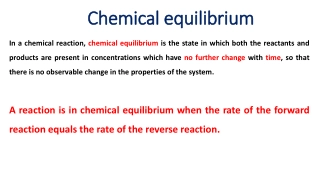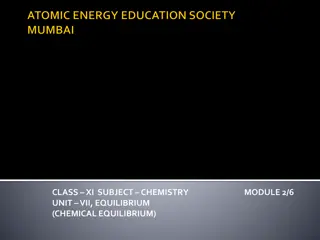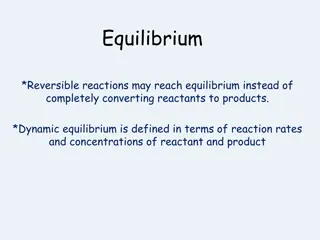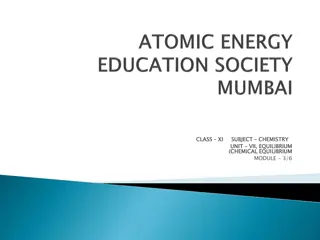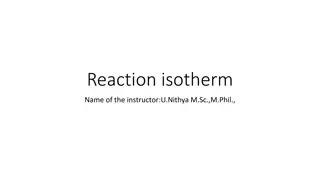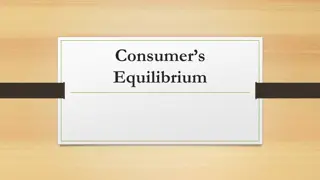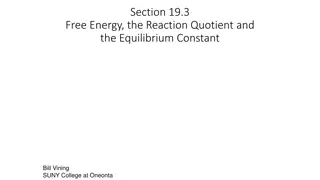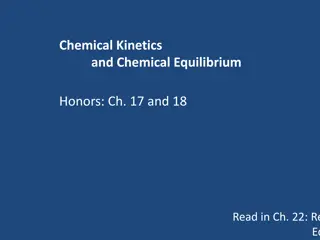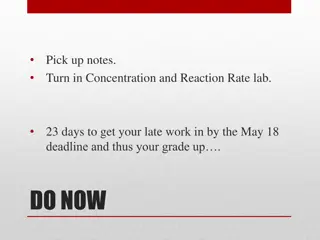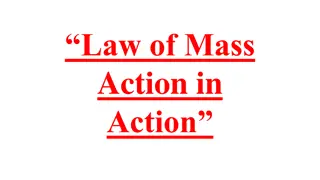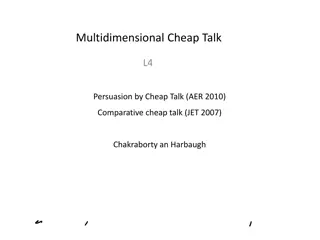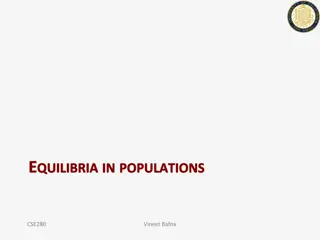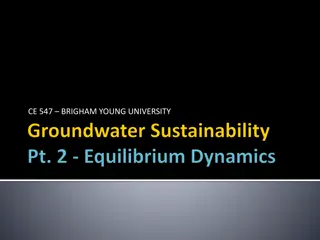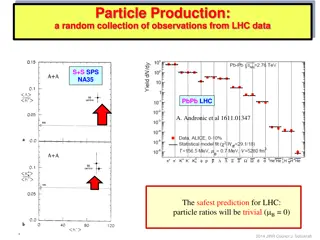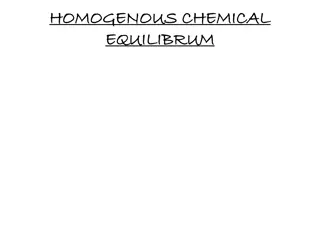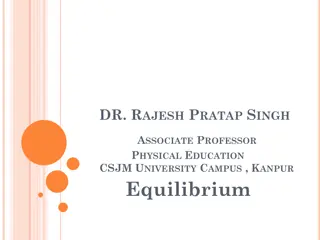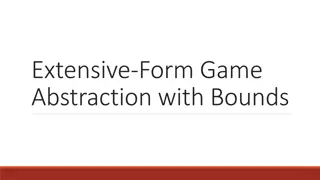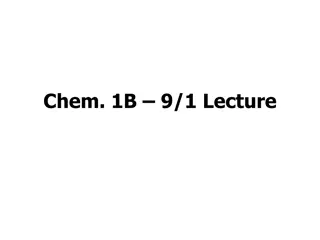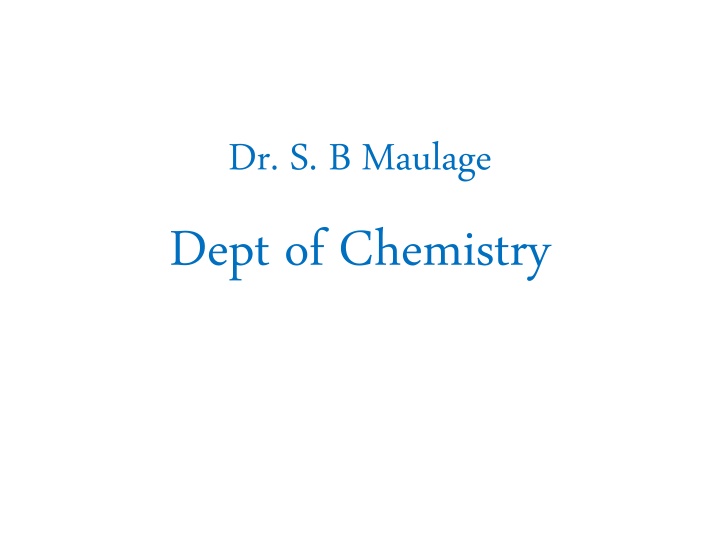
Chemical Equilibrium in Reactions
Learn about chemical equilibrium in reactions, where reactions can exist in a state of balance with forward and backward reactions. Explore reversible and irreversible reactions, their characteristics, and examples to understand the dynamic nature of equilibrium.
Download Presentation

Please find below an Image/Link to download the presentation.
The content on the website is provided AS IS for your information and personal use only. It may not be sold, licensed, or shared on other websites without obtaining consent from the author. If you encounter any issues during the download, it is possible that the publisher has removed the file from their server.
You are allowed to download the files provided on this website for personal or commercial use, subject to the condition that they are used lawfully. All files are the property of their respective owners.
The content on the website is provided AS IS for your information and personal use only. It may not be sold, licensed, or shared on other websites without obtaining consent from the author.
E N D
Presentation Transcript
Dr. S. B Maulage Dept of Chemistry
3. Chemical Equilibrium Whenever we hear the word Equilibrium immediately a picture arises in our mind an object under the influence of two opposing forces. For chemical reactions also this is true. A reaction also can exist in a state of equilibrium balancing forward and backward reactions.
A chemical reaction is said to have taken place when the concentration decreases, and the concentration of the products increases with time. The chemical reactions are classified on the basis of the extent to which they proceed, into the following two classes; of reactants
(1) Reversible reactions Reaction in which entire amount of the reactants is not converted into products is termed as reversible reaction. Characteristics of reversible reactions (a) These reactions can be started from either side, (b) These reactions are never complete, (c) These reactions have a tendency to attain a state of equilibrium, in which Free energy change is zero ( G = 0), (d) This sign ( ) represents the reversibility of the reaction,
Examples of reversible reactions Neutralisation between an acid and a base either of which or both are weak, Esterification Evaporation of water in a closed vessel
(2) Irreversible reactions Reaction in which entire amount of the reactants is converted into products is termed as irreversible reaction. (i) Characteristics of irreversible reactions (a) These reactions proceed only in one direction (forward direction), (b) These reactions can proceed to completion, (c) In an irreversible reaction, G < 0, (d) The arrow ( ) is placed between reactants and products,
Examples of irreversible reactions (a) Neutralisation between strong acid and strong base e.g.,
Equilibrium and Its dynamic nature Equilibrium is the state at which the concentration of reactants and products do not change with time. i.e. concentrations of reactants and products become constant.
The important characteristics of equilibrium state are, (1) Equilibrium state can be recognized by the constancy of certain measurable properties such as pressure, density, colour, concentration etc. by changing these conditions of the system, we can control the extent to which a reaction proceeds. (2) Equilibrium state can only be achieved in close vessel. (3) Equilibrium state is reversible in nature. (4) Equilibrium state is also dynamic in nature. (5) At equilibrium state, Rate of forward reaction = Rate of backward reaction (6) At equilibrium state, G = 0, so that H = T S.
Law of mass action and Equilibrium constant Goldberg and Waage (1864): The rate of a chemical reaction is directly proportional to the product of the molar concentrations of the reactants at a constant temperature at any given time. The molar concentration i.e. number of moles per litre is also called active mass. For example, molar concentration of A is expressed as [A].
Consider a simple reversible reaction a A + b B c C + d D According to law of mass action = a b a b [ ] [ ] [ ] [ ] A B k A B Rate of forward reaction f = c d c d C [ ] [ ] C [ ] [ ] D k D Rate of backward reaction b
At equilibrium , Rate of forward reaction = Rate of backward reaction = a b c d [ ] [ ] C [ ] [ ] k A B k D f b k c d [ ] [ ] C [ D [ f = = K c a b k ] ] A B b Where, is called equilibrium constant.
Characteristics of equilibrium constant (1) The value of equilibrium constant is independent of the original concentration of reactants. (2) The equilibrium constant has a definite value for every reaction at a particular temperature. However, it varies with change in temperature. (3) For a reversible reaction, the equilibrium constant for the forward reaction is inverse of the equilibrium constant for the backward reaction.
In general, 1 = K forward reaction backward K reaction (4) The value of an equilibrium constant tells the extent to which a reaction proceeds in the forward or reverse direction. (5) The equilibrium constant is independent of the presence of catalyst. (6) The value of equilibrium constant changes with the change of temperature.
Applications of equilibrium constant (1) Judging the extent of reaction (i) If , products predominate over reactants. If is very large, the reaction proceeds almost all the way to completion. (ii) If , reactants predominate over products. If Kcis very small, the reaction proceeds hardly at all. (iii) (iii) If Kc is in the range 10-3to 103, appreaciable concentration of both reactants and products are present. 10 3 K c 10 3 K c
(2) Predicting the direction of reaction : The concentration ratio, i.e., ratio of the product of concentrations of products to that of reactants is also known as concentration quotient and is denoted by Q. [ ][ ] X Y Q = Concentration quotient, [ ][ ] A B
It may be noted that Q becomes equal to equilibrium constant (K) when the reaction is at the equilibrium state. At equilibrium, [ A ][ ] X Y Q = [ ][ ] B Thus (i) If Q > K, the reaction will proceed in the direction of reactants (reverse reaction). (ii) If Q < K, the reaction will proceed in the direction of the products (forward reaction). (iii) If Q = K, the reaction mixture is already at equilibrium. Thus, a reaction has a tendency to form products if Q < K and to form reactants if Q > K. = = = Q K K K c p

